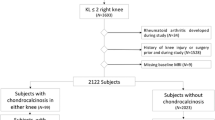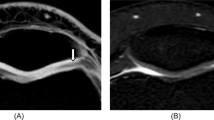Abstract
Delayed gadolinium-enhanced MRI of cartilage (dGEMRIC) was used for the measurement of relative proteoglycan depletion of articular cartilage in the patellofemoral (PF) joint following a proprietary protocol, which was compared with the X-ray images, proton density weighted MR images (PDWI) and arthroscopic findings. The study examined 30 knees. The ages ranged from 16 to 74 (average 40.3) years. The Gd-DTPA2–containing contrast medium was used in a single dose. The subjects were made to exercise the knee joint for 10 min; and MR images were taken 2 h after intravenous injection of contrast medium. T1-calculated images were produced and the region of interest (ROI) was set as follows. (1) ROI1: entire articular cartilage in a slice through the center of the patella. (2) ROI2: low signal region in T1-calculated images, which were set in a blind fashion by two observers. (3) ROI3: articular cartilage on one side that includes ROI2 where low signal region were detected (medial or lateral). ROI3 was set to examine the contrast of ROI2 with surrounding articular cartilage. The average T1 values of ROI1 was 393.5±33.6 ms for radiographic grade 0 and 361.3±11.1 ms for grade I, which showed a significant difference (P=0.036). The T1 value of ROI2 was 351.6±28.2 ms for grade I, 361.9±38.3 ms for grade II, 362.1±67.7 ms for grade III, and 297.8±54.1 ms for grade IV according to arthroscopic Outerbridge classification. All cases, that demonstrated decrease of T1 values on dGEMRIC (ROI2), showed abnormal arthroscopic or direct viewing findings. The ratio (ROI3/ROI2) in cases of only slight damage classified as Outerbridge grade I (6 cases) was an average of 1.04±0.02 and was 1.0 or greater in all cases, thereby indicating well-defined contrast with the surrounding cartilage. The diagnosis of damage in articular cartilage was possible in all 16 cases with radiographic K–L grade I on dGEMRIC, while the intensity changes were not found in 10 of 16 cases on PDWI. The dGEMRIC with a single-dose would be useful on a diagnosis of the area demonstrating early relative proteoglycan depletion in the articular cartilage of the PF joint prior to any discernible changes in the subchondral bone on X-ray images and exceeds to plain MR images for examining deterioration of articular cartilage.









Similar content being viewed by others
References
Burstein D, Velyvis J, Scott KT (2001) Protocol issues for delayed Gd (DTPA) 2−-enhanced MRI (dGEMRIC) for clinical evaluation of articular cartilage. Magn Reson Med 45:36–41
Gillis A, Gray M, Burstein D (2002) Relaxivity and diffusion of gadolinium agents in cartilage. Magn Reson Med 48(6):1068–1071
Haustein J, Laniado M, Niendorf HP (1993) Triple-dose versus standard-dose gadopentetate dimeglumine: a randomized study in 199 patients. Radiol Mar 186(3):855–860
In den Kleef JJ, Cuppen JJ (1987) RLSQ: T1, T2, and rho calculations, combining ratios and least squares. Magn Reson Med 5(6):513–524
Kellgren JH, Lawrence JS (1957) Radiological assessment of osteo-arthritis. Ann Rheum Dis 16:494–502
Masui T, Takehara Y, Aoshima R (1995) Acute hemodynamic effects of intravenous bolus injection of ionic and nonionic magnetic resonance contrast media. Acad Radiol 2(2):148–153
Outerbridge RE (1961) The etiology of chondromalacia patellae. J Bone Joint Surg [Br] 43B:752–757
Tiderius CJ, Olsson LE, de Verdier H (2001) Gd (DTPA)2−-enhanced MRI of femoral knee cartilage: a dose-response study in healthy volunteers. Magn Reson Med 46:1067–1071
Tiderius CJ, Olsson LE, Leander P (2003) Delayed Gadolinium-Enhanced MRI of Cartilage (dGEMRIC) in Early Knee Osteoarthritis. Magn Reson Med 49:488–492
Tiderius CJ, Svensson J, Leander P (2004) dGEMRIC (delayed gadolinium-enhanced mri of cartilage) indicates adaptive capacity of human knee cartilage. Magn Reson Med 51:286–290
Runge VM (2000) Safety of approved MR contrast media for intravenous injection. J Magn Reson Imaging 12(2):205–213
Samosky JT, Burstein D, Eric Grimson W (2005) Spatially-localized correlation of dGEMRIC-measured GAG distribution and mechanical stiffness in the human tibial plateau. J Orthop Res 23(1):93–101
Squires GR, Okouneff S, Ionescu M (2003) The pathobiology of focal lesion development in aging human articular cartilage and molecular matrix changes characteristic of osteoarthritis. Arthritis Rheum 48(5):1261–1270
Svaland MG, Christensen T, Lundorf E (1994) Comparison of the safety of standard and triple dose gadodiamide injection in MR imaging of the central nervous system. A double-blind study. Acta Radiol 35(4):396–399
Thurnher SA, Capelastegui A, Del Olmo FH (2001) Safety and effectiveness of single- versus triple-dose gadodiamide injection-enhanced MR angiography of the abdomen: a phase III double-blind multicenter study. Radiology 219(1):137–146
van der Harst MR, Brama PA, van de Lest CH (2004) An integral biochemical analysis of the main constituents of articular cartilage, subchondral and trabecular bone. Osteoarthritis Cartilage 12(9):752–761
van de Lest CH, Brama PA, van El B (2004) Extracellular matrix changes in early osteochondrotic defects in foals: a key role for collagen? Biochim Biophys Acta 1690(1):54–62
Watanabe A, Wada Y, Obata T (2004) dGEMRIC for evaluation of reparative cartilage after autologous chondrocytes implantation. Proc Intl Soc Mag Reson Med 11:2592
Williams A, Gillis A, McKenzie C (2004) Glycosaminoglycan distribution in cartilage as determined by delayed gadolinium-enhanced MRI of cartilage (dGEMRIC): potential clinical applications. American Roentgen Ray Society, pp 167–172
Williams A, Gillis A, McKenzie C (2004) dGEMRIC in Osteoarthritis: comparison with radiography. Proc Intl Soc Mag Reson Med 11:215
Author information
Authors and Affiliations
Corresponding author
Rights and permissions
About this article
Cite this article
Nojiri, T., Watanabe, N., Namura, T. et al. Utility of delayed gadolinium-enhanced MRI (dGEMRIC) for qualitative evaluation of articular cartilage of patellofemoral joint. Knee Surg Sports Traumatol Arthr 14, 718–723 (2006). https://doi.org/10.1007/s00167-005-0013-6
Received:
Accepted:
Published:
Issue Date:
DOI: https://doi.org/10.1007/s00167-005-0013-6




